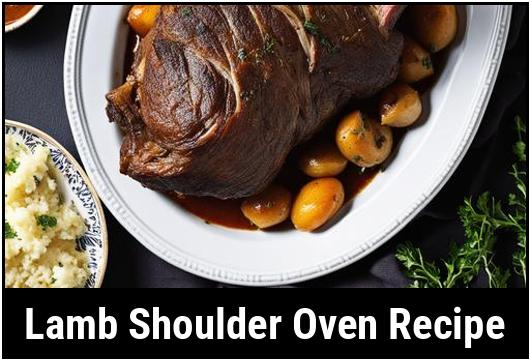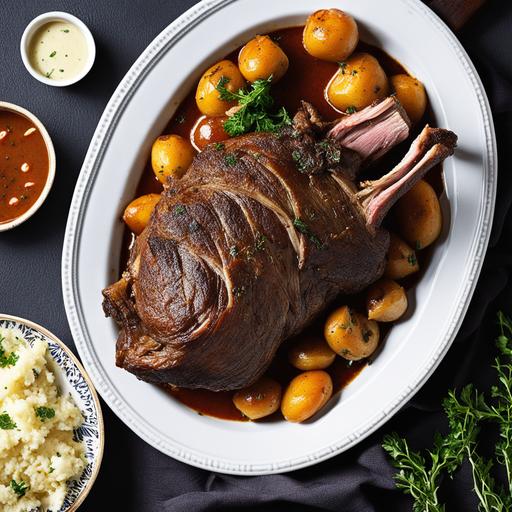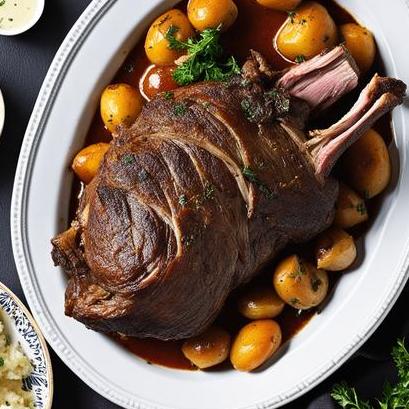
The Ultimate Guide To Lamb Shoulder Oven Recipe
Are you ready to impress your family and friends with a mouthwatering dish that will leave them begging for seconds? Look no further than the delicious and succulent lamb shoulder! In this comprehensive guide, we will delve into the art of preparing a perfect lamb shoulder in the oven, covering everything from food science to culinary details, selection, cleaning, preparation, tips, variations, doneness checks, and even avoiding the dreaded overcook or undercook. So, roll up your sleeves, sharpen your knives, and let’s dive into the world of lamb shoulder!
Understanding the Food Science behind Lamb Shoulder
Before we delve into the culinary aspects, let’s take a moment to understand the food science behind lamb shoulder. The shoulder is a heavily used muscle, resulting in a cut of meat that is rich in both connective tissue and flavor. This marbling of fat and collagen gives the lamb shoulder its prized tenderness and juiciness when cooked slowly and gently.
Selecting the Perfect Lamb Shoulder
A crucial step towards achieving a superb lamb shoulder dish is selecting the right cut of meat. Look for a lamb shoulder with a generous amount of fat marbling throughout the meat. This intramuscular fat will melt during cooking, keeping the meat moist and flavorful. Additionally, ensure that the shoulder is well-trimmed, removing any excess outer fat or connective tissue.
Cleaning and Preparing the Lamb Shoulder

Now that you have chosen the perfect lamb shoulder, it’s time to clean and prepare it for cooking. Start by rinsing the shoulder under cold water and patting it dry with paper towels. This ensures any surface contaminants are washed away. Next, you can proceed to trim off any large chunks of excess fat, but be careful not to remove too much as this fat contributes to both flavor and tenderness.
Expert Tips for Lamb Shoulder Preparation
To take your lamb shoulder to the next level, consider applying a dry rub or marinade. A dry rub consisting of your favorite spices can add an extra layer of flavor, while a marinade can help tenderize the meat further. Whichever method you choose, allow the lamb shoulder to marinate for at least two hours, or even overnight, refrigerated, for maximum flavor infusion.
Variations to Feast Your Taste Buds On
While a classic roasted lamb shoulder is already a culinary delight, there are numerous variations you can experiment with to add a personal touch to your dish. Consider incorporating herbs such as rosemary, thyme, or mint into your marinade or rub. Alternatively, you can go for a Mediterranean twist by infusing lemon zest, garlic, and oregano. The versatility of lamb shoulder opens up endless possibilities for creativity in your kitchen!
Achieving the Perfect Doneness – Lamb Shoulder Checkpoints

When it comes to cooking a lamb shoulder, achieving the perfect doneness can make all the difference between a sublime culinary experience and a disappointing one. The internal temperature of the lamb shoulder is the best indicator of its doneness. A digital meat thermometer is an essential tool for this purpose, ensuring accuracy and precision.
For medium-rare lamb shoulder, cook to an internal temperature of around 130°F (54°C) which will result in a rosy pink and moist center. If you prefer a more medium doneness, aim for an internal temperature between 140°F to 145°F (60°C to 63°C), yielding a slightly pink center. Remember, carryover cooking will continue to raise the temperature by a few degrees, so it’s advisable to remove the lamb shoulder from the oven slightly before it reaches the desired temperature.
The Showcase Recipe: Oven-Roasted Lamb Shoulder
Now that we have covered the essential aspects of lamb shoulder cooking, let’s move on to an exemplary recipe that will ignite your passion for this mouthwatering dish.
Ingredients:
-
1 lamb shoulder (approximately 5-6 pounds)
-
Dry rub or marinade of your choice
-
Salt and freshly ground black pepper
Instructions:
-
Preheat your oven to 325°F (163°C).
-
Place the lamb shoulder on a rack in a roasting pan, fat side up.
-
Apply the dry rub or marinade generously all over the shoulder, gently massaging it into the meat.
-
Season the lamb shoulder with salt and freshly ground black pepper to taste.
-
Insert a meat thermometer into the thickest part of the shoulder, avoiding the bone.
-
Place the roasting pan in the preheated oven and allow the lamb shoulder to cook slowly, approximately 20 minutes per pound.
-
Monitor the temperature on the meat thermometer and remove the lamb shoulder from the oven when it reaches the desired internal temperature mentioned earlier.
-
Once removed from the oven, let the lamb shoulder rest for 15-20 minutes, allowing the juices to redistribute within the meat.
-
Carve the lamb shoulder against the grain into thin slices and serve.
The Dreaded Overcook and Undercook – Avoid Them!
While cooking a lamb shoulder can be an exciting endeavor, there is always the risk of overcooking or undercooking it. Overcooking can result in a dry and tough texture, while undercooking may leave the meat chewy and unpleasant. To avoid these pitfalls, keep the following tips in mind:
-
Use a meat thermometer to monitor the internal temperature throughout the cooking process.
-
Allow the lamb shoulder to rest after cooking, as it continues to cook and reach the desired temperature during this time. This resting period also ensures the meat remains juicy and flavorful.
-
Be patient! Slow and low cooking is the key to achieving perfectly tender and succulent lamb shoulder.
In Conclusion
Congratulations! You are now armed with all the knowledge and expertise to take on the challenge of cooking a remarkable lamb shoulder in the oven. From food science to culinary details, selection, cleaning, preparation, tips, variations, doneness checks, and avoiding overcooking or undercooking, we have covered every aspect required for a successful and gratifying cooking experience. So, gather your ingredients, ignite your oven, and let the aroma of perfectly cooked lamb shoulder fill your kitchen. Get ready to wow your taste buds and bring smiles to the faces around your dining table with this culinary masterpiece!
Sources
FAQS On Lamb Shoulder Oven Recipe
What Is The Best Temperature To Cook A Lamb Shoulder In The Oven?
The ideal temperature to cook a lamb shoulder in the oven is 325°F (163°C). This lower temperature allows the meat to cook slowly and evenly, resulting in a tender and juicy end result.
How Long Does It Take To Cook A Lamb Shoulder In The Oven?
A general rule of thumb is to cook a lamb shoulder in the oven for approximately 20 minutes per pound. Therefore, a 5-pound lamb shoulder would take around 1 hour and 40 minutes to cook. However, it’s important to use a meat thermometer to ensure the internal temperature reaches 145°F (63°C) for medium-rare or 160°F (71°C) for medium doneness.
Should I Cover The Lamb Shoulder While Cooking In The Oven?
Yes, it’s recommended to cover the lamb shoulder while cooking in the oven for the first two-thirds of the cooking time. This will help the meat retain its moisture and tenderness. Uncover the lamb shoulder for the last portion of the cooking time to allow the exterior to brown and develop a crispy crust.
How Should I Season A Lamb Shoulder Before Cooking In The Oven?
To enhance the flavor of the lamb shoulder, you can season it with a mixture of salt, pepper, garlic, rosemary, and thyme. You can also create a marinade using olive oil, lemon juice, and your choice of herbs and spices. Allow the lamb shoulder to marinate for a few hours or overnight in the refrigerator for maximum flavor infusion.
What Are Some Recommended Side Dishes To Serve With A Lamb Shoulder Cooked In The Oven?
Some popular side dishes to pair with a lamb shoulder include roasted vegetables such as carrots, potatoes, and Brussels sprouts. Additionally, a light and fresh salad or a side of couscous or rice can complement the richness of the lamb shoulder. A glass of red wine or a mint sauce can also enhance the overall dining experience.



